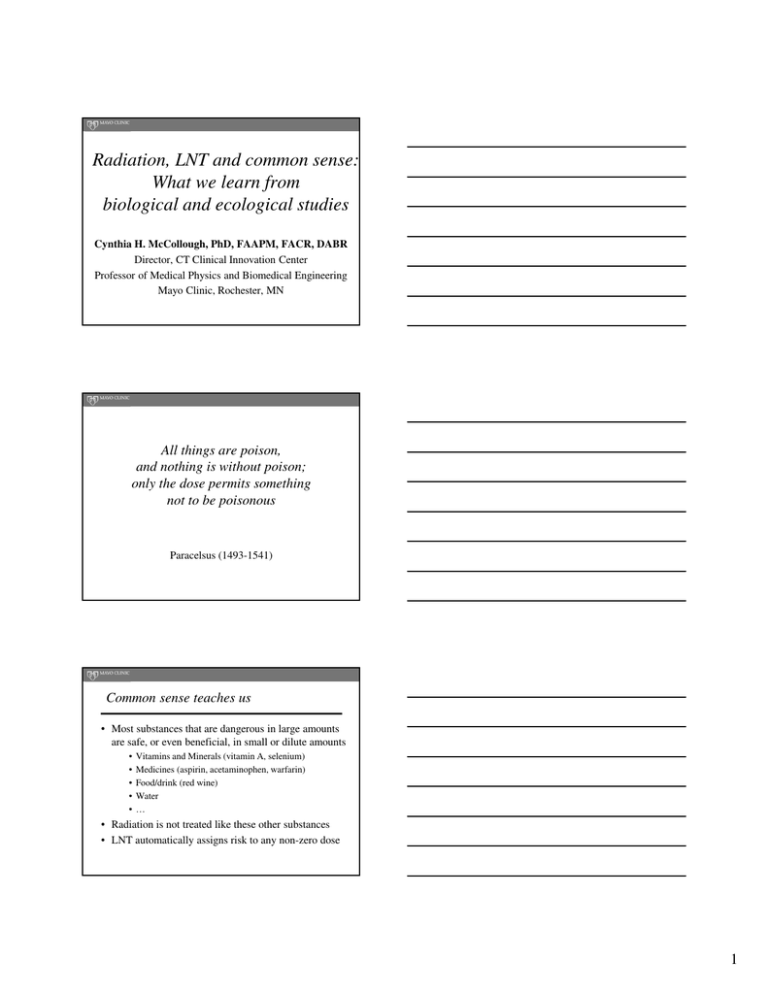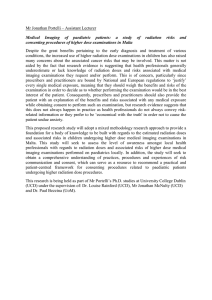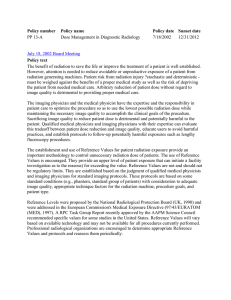Radiation, LNT and common sense: What we learn from
advertisement

Radiation, LNT and common sense: What we learn from biological and ecological studies Cynthia H. McCollough, PhD, FAAPM, FACR, DABR Director, CT Clinical Innovation Center Professor of Medical Physics and Biomedical Engineering Mayo Clinic, Rochester, MN All things are poison, and nothing is without poison; only the dose permits something not to be poisonous Paracelsus (1493-1541) Common sense teaches us • Most substances that are dangerous in large amounts are safe, or even beneficial, in small or dilute amounts • • • • • Vitamins and Minerals (vitamin A, selenium) Medicines (aspirin, acetaminophen, warfarin) Food/drink (red wine) Water … • Radiation is not treated like these other substances • LNT automatically assigns risk to any non-zero dose 1 Radiation biology teaches us • Most experimental data in controlled systems (cells and animals) suggest that linear extrapolation from high doses to low doses will OVERESTIMATE cancer risks at low doses – DDREF (Dose and Dose Rate Effectiveness Factor) attempts to account for this • True for high or low dose rates • Data suggest a dose threshold Radiation biology teaches us • Primary damage linear with dose, secondary damage often non-linear • Complex biological systems have physiological barriers and repair mechanisms against damage and disease • Propagation to clinical disease is complex Low dose effects differ from high dose effects • Quantitatively and qualitatively • At low doses, protection is conferred by – – – – Altered gene and protein expression Epigenetic changes Oxidative status of the cell Apoptosis (transformed cells are eliminated by cell suicide) 2 Dose dependent gene expression Low Dose Genes # of Genes switched on High Dose Genes 0 100 1000 10000 Dose (mGy) Wyrobek, Radiat. Res. 164, 369–382 (2005) Biological systems are not cell cultures • The human body has multiple levels of intra- and intercellular communication mechanisms • Damage to individual cells from exposure to ionizing radiation can be communicated to neighboring cells and the host via a number of communication channels • These communication channels may persist when irradiated tissue is transferred to a new host, and between organisms in a social network (e.g. fish tank, mouse colony) 2006 French Academies of Science report • Focused on radiobiological science • Did not interpret data in context of radiation protection policy (as did BEIR VII) • Did not support LNT Radiology 251 (2009) 3 Low levels of ionizing radiation (< 100 mGy) • Can trigger a response of the host’s immune system and confer health benefits • Can induce a protective (adaptive) response to subsequent radiation exposures and confer a health benefit • Uses a variety of pathways to signal and alter host response to radiation • Many complex interactions in the organism modulate the damage done to individual cells Not a one sided story Production of damage Responses to damage Linear processes Deposition of energy DNA damage Non-linear processes Induction of Apoptosis Gene & protein expression Physics Biology Can we measure bioeffects of CT doses? • Most biodosimetric measurements have involved the analysis of radiation-induced chromosomal alterations in blood lymphocytes. • The sensitivity is low, so that only x-ray doses greater than 100 mGy can be assessed reliably. Bauchinger M. Quantification of low-level radiation exposure by conventional chromosome aberration analysis. Mutat Res. 1995;339:177–189. Edwards AA, Lindholm C, Darroudi F, et al. Review of translocations detected by FISH for retrospective biological dosimetry applications. Radiat Prot Dosimetry. 2005;113:396–402. 4 • A new technique allows detection and quantification of DNA-damage at CT dose levels. • Double-strand breaks (DSBs) form cytologically visible “foci” at immunofluorescence microscopy. • Number of DSBs induced by CT corresponded to the calculated dose and was linearly dependent on the dose length product. Lobrich M, Rief N, Kuhne M, et al. In vivo formation and repair of DNA double-strand breaks after computed tomography examinations. Proc Natl Acad Sci USA. 2005;102:8984-8989. Rothkamm K, Balroop S, Shekhdar J, et al. Leukocyte DNA damage after multi-detector row CT: a quantitative biomarker of low-level radiation exposure. Radiology. 2007;242:244–251. Skull CT Patient had previously shown exceptionally severe side effects after radiotherapy and was shown to have a DSB repair mechanism defect. At 24 h after CT, all other individuals displayed background levels of DSB. 5 Summary • Cells detect and respond to very low doses of radiation • The mechanisms of action differ between low and high doses • The response to high doses is detrimental while the response to low doses is protective • Repair mechanisms may completely repair DNA damage from CT dose levels • LNT cannot be applied to estimate risk from medical imaging Ecological Epidemiology Studies Correlation of mean characteristics of a group to look for potential relationships between variables Radiation Doses from Gamma Rays 6 Radiation Doses from Radon Radiation Doses from Weapons Testing Simon et al. 2006 US Cancer Rates 7 Biological effects of radiation… • Could be good, bad, or neutral • Small - unable to be convincingly demonstrated • Dependent on many individual factors, including gender, age, genetics, other stressors, diet … • Cannot be described accurately based solely on epidemiology • Biological data must be incorporated into any potential risk model Mayo Clinic CT Clinical Innovation Center http://mayoresearch.mayo.edu/mayo/research/ctcic 8



